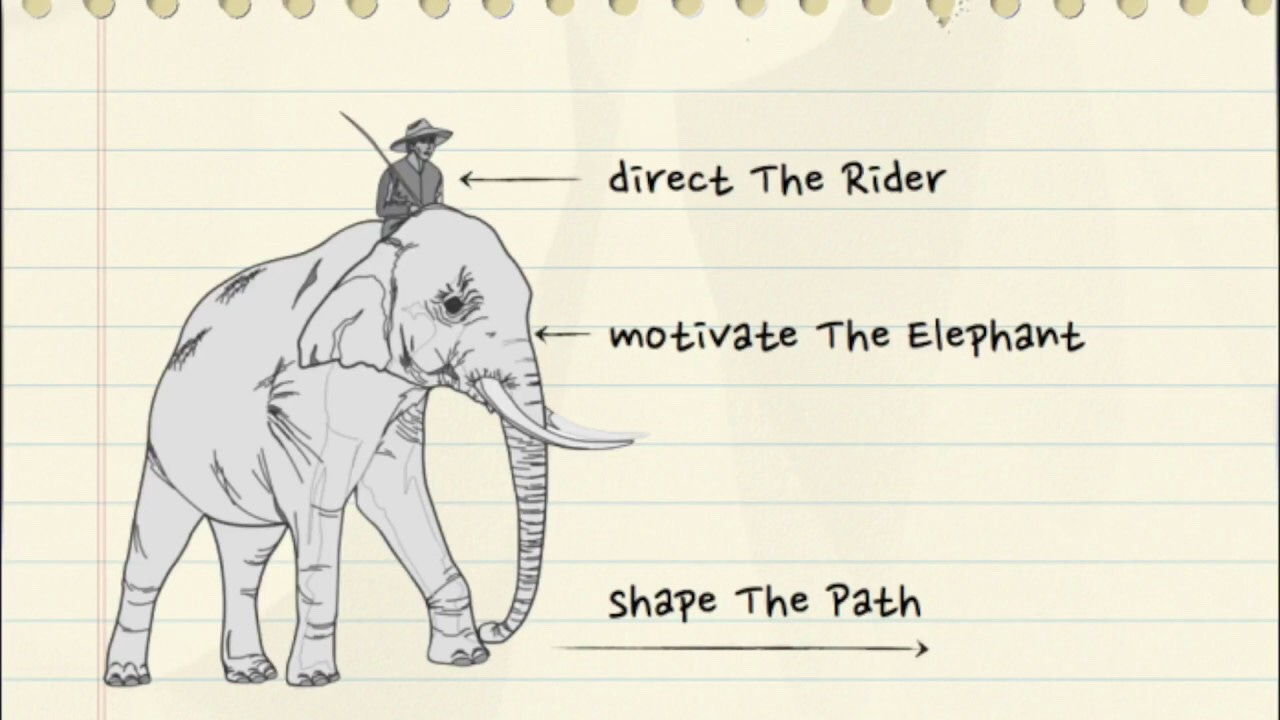Switch: How to Change Things When Change Is Hard 📖
Read to know about what this book is all about.
When we are making a decision we’re often torn between our Rational, logical reasons, and our Emotional, intuitive feelings!
Before Proceeding, one thing:
TelEmpathy also provides access to qualified mental health professionals
Click on the button below to know more.
One could think of the process of making decisions as a Rider (The Rational Mind) riding an Elephant (The Emotional Mind) waking along a Path (The Environment).
Your job is to direct the rider by giving clear directions to avoid decision paralysis, motivate the elephant by finding the emotional connection, shape the path by removing obstacles, adjusting the environment, and allowing the journey to take an easier path!
To implement change, you need to do three things (3):
1. Direct the Rider
The Rider loves to contemplate, analyze, and focus on problems instead of solutions! The rider is frustrated by uncertainty & can easily get exhausted.
a) Follow the Bright Spots— Investigate what’s working & duplicate it.
b)Note the Critical Moves— Think go specific behaviors you’d like to change.
c) Point to the Destination — Change becomes easier when you know where you’re going & why it’s worth it.
2. Motivate the Elephant
The elephant can easily get scared & hates doing things without immediate benefits. The elephant is stubborn, needs reassurance, and is quickly demotivated. The elephant is powerful yet difficult to actively direct.
a)Find the Feeling — Knowing something isn’t enough to cause change; you need to make people feel it.
b) Shrink the Change— Break down the change until it does not scare the elephant.
c) Grow your People — Develop a sense of identity & culture of a growth mindset.
3. Shape the Path
Even when the rider & elephant corporate; they must know their direction! Without a clear destination, change will not happen! The elephant tends to follow the path of least resistance, which might not be the right path to take.
a) Adjust the Environment— When the situation changes; behavior changes, so focus your efforts on changing the perception of the situation.
b) Build Habits — Look for ways to encourage desirable habits because it makes it easier on the rider.
c) Spread the Word— Behavior is contagious, so help it spread.
Takeaways…
The 10 Things Leaders Need to Know about Implementing Positive Changes:
1. Our emotions can overwhelm our rational thought while relying solely on rational behavior can “overanalyze & overthink things.”
2. Most likely changes are plain & simple, but one would have to set forth a goal to achieve the desired change.
3. What looks like a people problem is often a situation problem. All change efforts usually have something in common: “For anything to change, someone has to start acting differently.” But the question is always that, “Can you get people to start behaving in a new way?”
4. What looks like laziness is often exhaustion. The Elephant & Rider are usually on two different pages & the Rider trying to persuade the Elephant often exhausts the Rider’s mind. The Elephant will usually win over the Rider, so the Rider needs to appeal to the Elephant.
5. The Rider part of our minds has many strengths. The Rider is a thinker & a planner & can plan, but the Rider has a terrible weakness- the tendency to spin his wheels. The Rider loves to contemplate & analyze, and to make matters worse, his analysis is almost always directed at problems rather than at bright spots (negative thinking).
6. Sometimes we tend to make the default plan because that was the first plan given to us & when looking at the facts we look at the negative side, which then leads us to our first decision, which may not always be the best.
7. Leaders should make sure their goals are reachable & specific. If not, they may tend to go in circles when trying to achieve their goals. Taking small steps is the best way to achieve any big change in our lives. Too big of a step can end up being too overwhelming, which results in disappointment & cause us to give up more easily.
8. In highly successful change efforts, people find ways to help others see the problems or solutions in ways that influence emotions, not just thought. In other words, when change works, it’s because leaders are speaking to the Elephant as well as to the Rider. Change only works if the Elephant & Rider are working together!
9. The gates of large goals are lined with small accomplishments. Remember to compliment yourself when completing little steps towards your goal, it will help motivate you.
10. One can’t learn to do anything without failing, and the Elephant really, really, really hates to fail! So how is it that you keep the Elephant motivated to not give up? The answer may sound strange: You need to create the expectation of failure, not the failure of the mission itself, but failures along the way towards success!
In what ways will you implement change at your organization & in your life (personal & professional)?
Share this article on WhatsApp & LinkedIn
Liked the content? Give us a Like ❤️️ & Comment your views
Have a great week ahead😄






